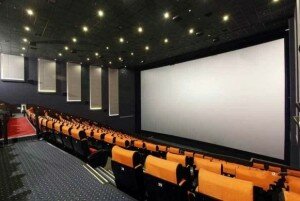Prometheus 3D released in DMAX-3D in preference to IMAX
Ridley Scott’s first 3D movie Prometheus was released in China yesterday, now the summer domestic protection period is over. However, its release signifies the start of a potential format battle as China’s DMAX 3D format has been favoured over IMAX.

Despite operating over 90 IMAX theatres in China, not one of those will be screening the Aliens prequel. IMAX Corporation is contracted to open 225 theatres in China but they won’t enjoy the monopoly they have in other territories as there is a new format in town – DMAX (not to be confused with Discovery’s ‘Wife Swap’ channel).
 DMAX (Digital Max) was developed by the China Film Institute of Science and Technology and the state-backed China Film Company Limited. The screens are smaller than their Canadian rival’s standard of 22 x 16 metres, at 20 m × 12 meters. The first commercial use was in a cinema in the eastern province of Anhui in April this year, just in time for the release of the hugely popular Chinese version of Titanic 3D.
DMAX (Digital Max) was developed by the China Film Institute of Science and Technology and the state-backed China Film Company Limited. The screens are smaller than their Canadian rival’s standard of 22 x 16 metres, at 20 m × 12 meters. The first commercial use was in a cinema in the eastern province of Anhui in April this year, just in time for the release of the hugely popular Chinese version of Titanic 3D.
DMAX-3D projection is said to be nearly 20% brighter than IMAX 3D, important when considering how much light the glasses block, but Don Savant, Senior Vice President of IMAX Asia-Pacific region has stated that the picture quality of both formats is not comparible… "Despite DMAX also being a dual show, its picture quality and IMAX is not the same. IMAX uses exclusive technology to scan the ordinary 35mm film, printing to 70mm film through the upgrade process. DMAX dual projection equipment is a 2K machine and the successor will be upgraded to 4K but the real IMAX film resolution is over 6K so the quality difference is obvious”.
DMAX is said to be comparable to the IMAX DMR process (IMAX's Digital Media Remastering process which converts conventional films to a format suitable for IMAX presentation). Unlike true IMAX films, DMAX films are not shot using DMAX cameras. This has led some to complain of inferior quality but it does circumvent many of the financial and geographical restrictions imposed by IMAX.
The agenda of the China Research Institute of Film Science and Technology was to avoid the high royalty costs charged by the IMAX Corporation and this translates to lower end user ticket prices. An ordinary 3D movie fare costs between 70 to 80 Yuan; the DMAX-3D fare is 90 to 100 Yuan and IMAX 3D fares costs between 150 and 180 Yuan. (1 Yuan is about 10 pence or 16 US cents). It is also expensive to maintain an IMAX cinema with its projector alone costing 10 million yuan ($1.58 million) and many of the profits leave China.

Another financial advantage is that the domestic DMAX technology costs considerably less to install at one million Yuan per unit. Also, unlike IMAX who command 15% of the box office shares as well as copyright and maintenance fees, cinemas are not forced to pay any box office or copyright fees for the DMAX system.
Combine those financial incentives with IMAX Corporation’s 5 kilometre protection zone per IMAX theatre and the company’s lack of interest in converting Chinese made movies and it is easy to understand why IMAX could struggle in the world’s biggest 3D film market.
Prometheus, which was available in IMAX 3D, has only been released in the DMAX-3D format in China, advertised on posters as “Giant Screen 3D”. This exclusive arrangement appears to cement China’s commitment to the alternative format despite it being an experimental format only few months ago according to Yang Xuepei, director of the China Research Institute of Film Science & Technology and pioneer of DMAX.
<<10 REASONS TO JOIN 3D FOCUS PRO INCLUDING TRIAL OFFER!>>
20th Century Fox has said it is not their decision as to what format the studio's movies are shown in but future releases are likely to be a combination of both. They are unlikely to care as long as the revenue is generated of which there is huge potential in China. Fox released Titanic 3D and 'This Means War' in DMAX-3D and Universal Pictures released Battleship in the domestic format too. The conversions were made under the China Film Group Distribution pact,
IMAX 3D versions may follow but Don Savant has said he is not concerned as the IMAX version was popular outside of China and it has been a long time since the original release date. Fu Ruoqing, deputy general manager of China Film Group Corporation is more bullish saying "With DMAX, China has entered the world stage of hi-tech film format," Fu said.
"DMAX will have abundant screening sources, and neither cinema chains nor filmgoers need to pay much considering the moderate patent fees for its technology. "It might break the monopoly of IMAX in our cinema market," said Yang Buting, head of the China Film Distribution and Exhibition Association.
In response, IMAX Corporation are considering reducing ticket prices in China, recognising the cheaper competition but also the huge opportunity in China with a fast growing middle class. China is now the second largest market for IMAX around the world after the United States.
<
Chinese cinema Chain UME Shuangjing claims DMAX offers films in better colour by using the world's brightest projector and Yang Xuepei has said they have the IP over the product and the quality is superior saying "After three years, the quality is equal to IMAX. In everything, from design to image optimization, sound system to overall technology, DMAX has superior quality. Our stereo system is better than IMAX's, our's has a 11.1 channel system. IMAX has 7.1," said Yang.
However, others are not so sure. Talking to Global Times, University student and avid cinemagoer Wang Fan, 23, says image resolution on DMAX screens falls short of IMAX's high standards. "I have watched many films both in DMAX and IMAX and found DMAX's still images are fine. However, its quality of moving pictures is often blurry, which rarely happens with IMAX films," said Wang.

Many people also question DMAX's claims as an "integrated system." A cinema industry insider said DMAX comes across as a hodgepodge of foreign cinematic technology rather than a viable Chinese alternative. "The projector and sound technology is from Belgian company Barco, the screen is from British company Harkness and the 3D technology is from Korean company Masterimage,"
China Film Stellar Theatre Chain signed an agreement to purchase 18 of the screens and they will join by other large screen formats produced by theatres chains and research groups such as like ShiMao Cinema Investment Development Co’s ShiMao Vision large film brand who intend to produce 22 large film screens by the end of 2014. Regal Cinemas have RPX system, AMC Cinemas' ETX system and Village Cinemas' VMAX system.
Not only is China’s 3D film market booming, thanks in part to Government policy, the large screen format market could also be the most competitive and innovative in the world, breaking the IMAX monopoly they have enjoyed for so long in the west.
Prometheus 3D will be released as a director’s cut on 3D Blu-ray on October 8th. It is available to pre-order from Amazon . Images are from Chinatechgadget.com.
FREE WEEKLY 3D NEWS BULLETIN –



















